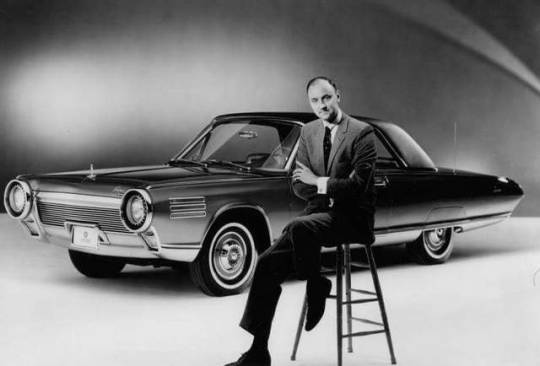#Elwood Engel
Text
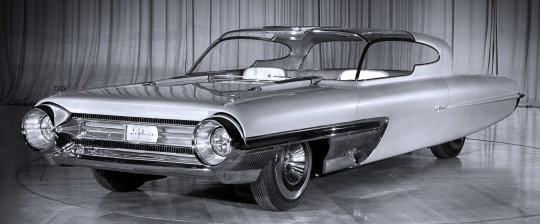
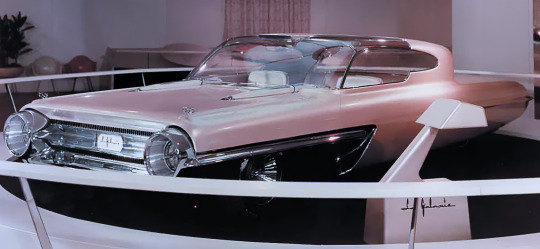

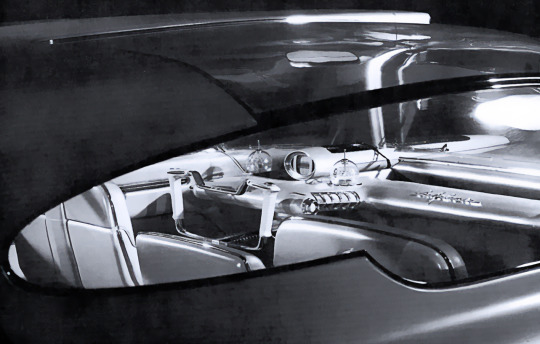

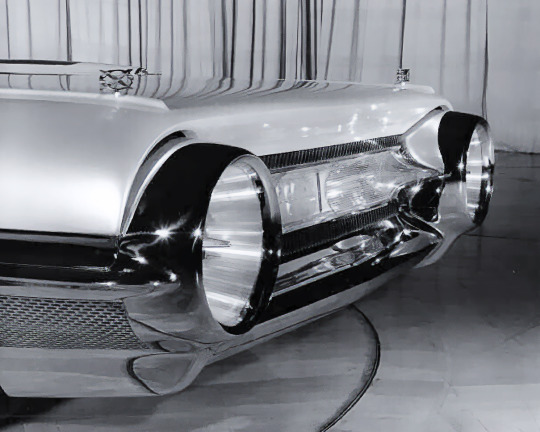

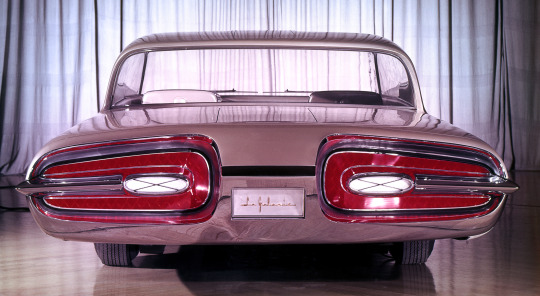
Ford La Galaxie, 1958. Designed by Elwood Engel using jet plane styling and futuristic detailing, the La Galaxie was the centrepiece of Ford's stand at the Chicago Auto Show. The reverse-angle rear window featured on Lincolns and Mercurys in the lat 50s and early 60s. Engle moved to Chrysler where he recycled some of the La Galaxie's styling for the 1963 Chrysler Turbine car. Like many "dream cars"of the 50s and 60s the La Galaxie was destroyed after its brief show career
#Ford#1958#Ford La Galaxie#Elwood Engel#retro futuristic#dream car#concept#design study#pillarless hardtop#Chicago Auto Show#1950s
749 notes
·
View notes
Text
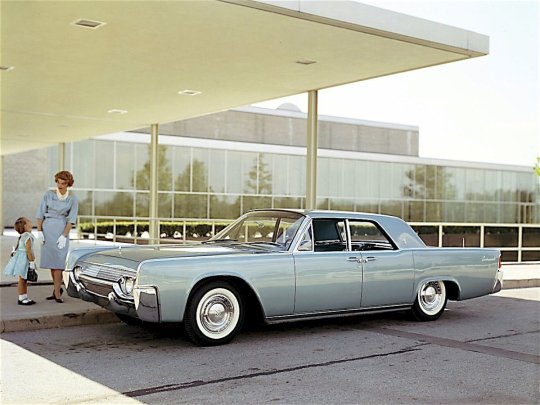
1961 Lincoln Continental
The 1961 Lincoln Continental: A Timeless American Classic of Elegance and Innovation
In the realm of classic American luxury automobiles, the 1961 Lincoln Continental stands as a symbol of elegance, innovation, and timeless design. A departure from the ornate styling of the 1950s, the '61 Continental marked a shift towards clean lines, understated luxury, and a new era of automotive design. In this article, we'll take a comprehensive look at the history, design, engineering, cultural impact, and enduring legacy of the 1961 Lincoln Continental.
The Dawn of a New Decade

The early 1960s marked a transition from the extravagant designs of the 1950s to a more refined, streamlined aesthetic. The 1961 Lincoln Continental epitomized this shift, embracing a sense of understated elegance that resonated with the changing times. As the United States entered a new era, the Continental reflected the desire for sophistication and modernity.
Timeless Design: The Art of Proportion
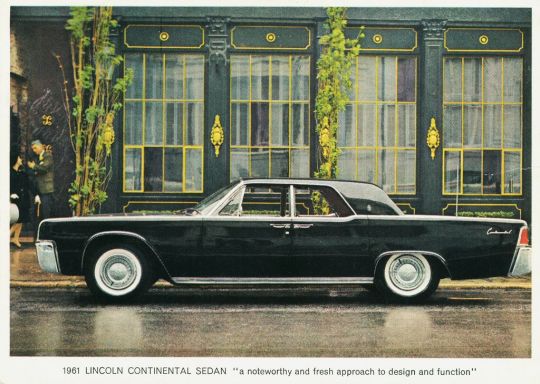
The hallmark of the 1961 Lincoln Continental's design was its commitment to proportion and minimalism. Spearheaded by chief designer Elwood Engel, the Continental introduced the concept of "slab-sided" styling, characterized by clean lines, uncluttered surfaces, and a seamless integration of form and function. This design philosophy elevated the Continental's visual appeal, giving it an enduring aura of sophistication.
Distinctive Features: Suicide Doors and Grille Design

One of the most iconic features of the 1961 Lincoln Continental was its unique suicide doors, which opened toward the rear of the vehicle. This design element not only added a touch of drama but also facilitated easy ingress and egress for passengers. Additionally, the bold front grille design, reminiscent of classic automobiles, became synonymous with the Continental's refined presence on the road.

Engineering Excellence: Power and Performance

Underneath its sleek exterior, the 1961 Lincoln Continental boasted engineering prowess. The Continental was powered by a potent V8 engine that delivered ample power for effortless cruising. This blend of power and performance was complemented by the Continental's smooth suspension and refined handling, ensuring a comfortable and commanding driving experience.
Interior Splendor: Craftsmanship and Comfort
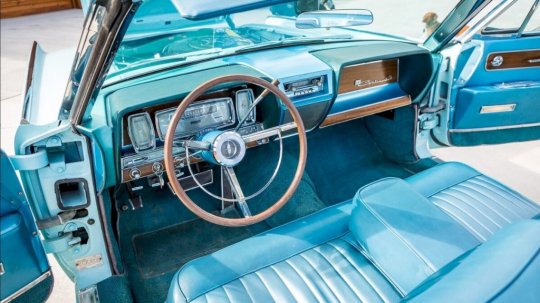
Step inside the 1961 Lincoln Continental, and you're greeted by a world of opulence and refinement. The interior was a masterclass in craftsmanship, with rich materials, plush upholstery, and meticulous attention to detail. Every aspect of the interior was designed to cocoon occupants in comfort and luxury, creating an oasis of tranquility on the open road.
Influence on American Culture: Symbol of Prestige
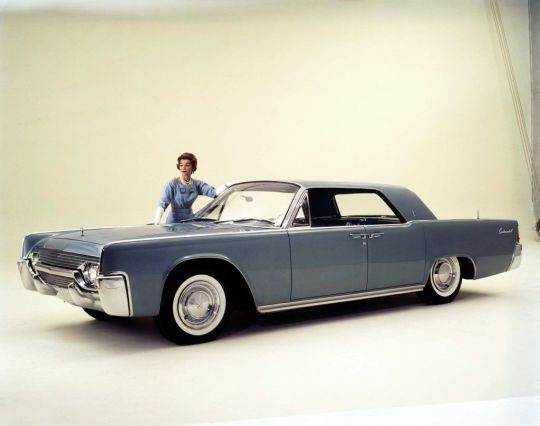
The 1961 Lincoln Continental became a symbol of prestige and sophistication, often associated with influential figures of the era. Its presence graced the driveways of Hollywood stars, politicians, and affluent individuals, solidifying its status as a vehicle of choice for those who valued luxury and style.
A Cultural Icon: From Film to Fashion

The allure of the 1961 Lincoln Continental extended beyond the realm of automobiles. Its appearances in movies and television shows further cemented its status as a cultural icon. Additionally, the Continental's design elements, such as the iconic grille and suicide doors, became references in fashion and design, highlighting its lasting impact on popular culture.
The Legacy Lives On: Inspiration for Future Generations

The legacy of the 1961 Lincoln Continental lives on through its design philosophy and enduring influence on automotive aesthetics. Its emphasis on timeless design, elegance, and innovation continues to inspire automotive designers and enthusiasts, shaping the way luxury vehicles are conceived and crafted.
Collector's Dream: Rarity and Appreciation
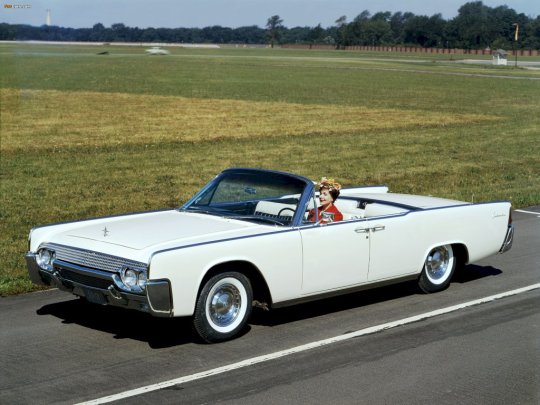
Today, the 1961 Lincoln Continental holds a special place in the hearts of collectors and enthusiasts. Its limited production numbers and iconic status have elevated its value as a classic automobile. Owning a 1961 Continental is not just a possession; it's a connection to a defining era of automotive history and a testament to the artistry of automotive design.
Conclusion: A Timeless Beacon of Elegance

The 1961 Lincoln Continental stands as a testament to the marriage of art and engineering, capturing the essence of elegance and sophistication that defined an era. Its legacy as an automotive masterpiece continues to resonate with those who appreciate the fusion of design, craftsmanship, and performance. The 1961 Lincoln Continental remains an enduring symbol of an age when cars were not just modes of transportation, but expressions of style, luxury, and innovation that transcend time.
91 notes
·
View notes
Link
1968 Dodge Topless Charger Concept #StoryCars #ConceptCars #ConceptCar
0 notes
Photo

New Post has been published on https://fastmusclecar.com/the-debate-continues-was-the-max-wedge-or-the-gto-the-first-muscle-car/best-muscle-cars/
The Debate Continues: Was the Max Wedge or the GTO the First Muscle Car?
For many car enthusiasts, the question of what was the first muscle car ever created divides opinion, and it is often argued that it was the 1964 Pontiac GTO that truly kicked off the era. However, two years prior to this, the 1962 Plymouth Fury Max Wedge had already been built, with a larger engine, higher horsepower and a three-speed TorqueFlite automatic transmission – so why does the answer for the era’s starting point rarely seem to include this car?
The styling for the 1962 Plymouth Fury Max Wedge looked to be a transitional step between the 1950s designs and the later 1960s models, and Elwood Engel’s efforts can be seen all over the car. The infamous Pontiac GTO of 1964 had a base price of around $2,491 – the Plymouth Fury Max Wedge in contrast cost $3,308. Despite the power and quality of the Max Wedge, just 298 cars were built (all models) in comparison to Pontiac’s 32,540 – over 100 times more. As such, it seems that the popularity of the GTO gave it an far bigger spotlight to be seen as the original template.
The Max Wedge formula actually began back in 1958, when Chrysler’s powertrain planning team developed the lightweight “B” series V8 big-block with a wedge-shaped combustion chamber, used in engine sizes of both 350 and 361 cubic inches. This provided the necessary quench area for improved performance, and the ‘RB’ version was released in 1959, with the 413ci RB-series engine eventually finding its way into the original Max Wedge cars. With its specification of a 410/420 horsepower engine, these cars were only available for use in competitions, and many argue that this is why the GTO has been widely considered as the first muscle car.
It is also worth noting that the Max Wedge included a three-speed TorqueFlite automatic transmission, which offered flawless shifting. GM would not get the TH400 until 1965, and Ford would not get its own three-speed automatic until 1966 – highlighting that Chrysler had a complete transmission dominance for three years. The development of the Max Wedge continued in 1964 with the 426ci engine, but it was suspended when the Hemi engine began production.
The platforms for chassis and engine combinations like the Max Wedge and GTO began on body-on-frame designs from Chrysler (Plymouth and Dodge) and Ford (Fairlane). And though the availability time period was different, the fundamental idea of putting large-displacement engines into lightweight production vehicles remained the same. This gave rise to performance-grade road cars where drivers could feel the power of the engine, and the chases we now associate with muscle cars began.
The Max Wedge continued to be a successful platform in 1964. Although the 426ci engine was discontinued in mid-1964, the Max Wedge still remained incredibly powerful. In fact, the Max Wedge engine held the record for power output from an American production engine until the introduction of the legendary 426 Hemi in 1966.
The Max Wedge was also a pioneer in terms of race-spec performance parts. Chrysler offered lightweight aluminium parts for their stock Max Wedge cars, including special valve covers, intake and exhaust manifolds. These parts, combined with the high-compression heads and dual four-barrel carburettors, helped to make the Max Wedge one of the most powerful production cars at the time.
The debate about the importance of the Pontiac GTO or the Max Wedge will probably never end. But it should be noted that the Max Wedge’s influence is still widely felt today in the higher valuations and the nostalgia that goes along with it. So while the Pontiac might have been a commercial success, the heavily-modified Max Wedge cars stand as a testament to the beginnings of the muscle car era. Tune in to MotorTrend TV and MotorTrend+ to find out more about Max Wedge and other classic vehicles.
0 notes
Photo


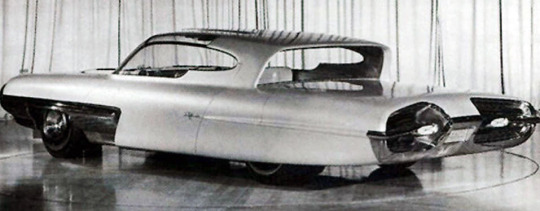
Ford La Galaxie, 1957. A futuristic concept car designed by Elwood Engel that was presented at the Chicago Auto Show
1 note
·
View note
Photo


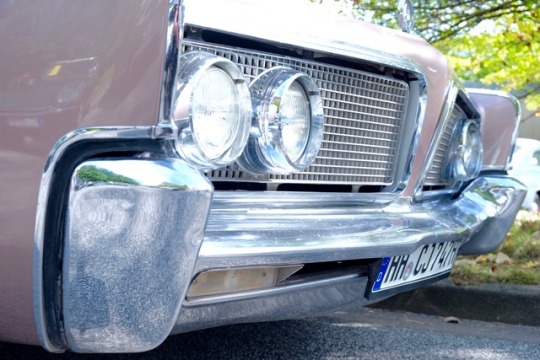
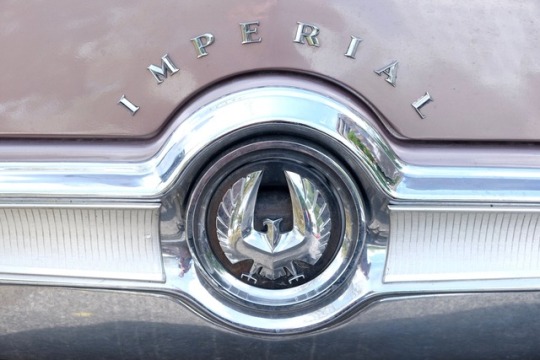
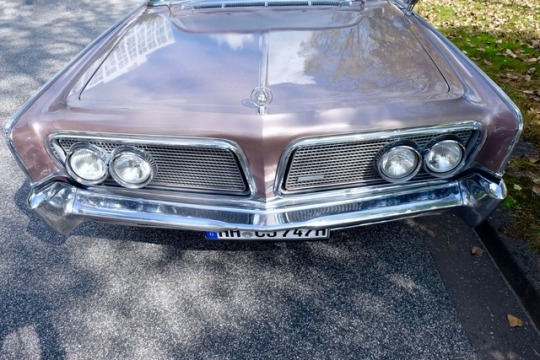


Full-sized cars for long days
The Imperial was much more than a top-of-the-line automobile for the Chrysler Corporation. Founded in 1955 the Imperial Division was Chrysler Corporation's unique luxury brand until 1975 with a brief reappearance from 1981 to 1983. This 1964 Imperial Crown, powered by a massive 413 cubic-inch, 350 horsepower V8, could compete with Lincolns (which it looked like in parts somehow, because Chrysler hired designer Elwood Engel from Ford in 1961) and Cadillacs. An Imperial-exclusive assembly line had been the inspiration for the 1960 ad theme „America's Most Carefully Built Car”.
#crown imperial#imperial crown#chrysler imperial#chrysler corporation#elwood engel#full-size cars#classic cars#luxury#1964#made in usa#hamburg#photographers on tumblr#original content#autolandish#streetfightingcars#car spotting#chrysler#classic v8#v8#hemi#luxury cars#us cars#virgil exner
39 notes
·
View notes
Photo

Sydney Jay Mead (American, born 1933). Elwood Engel Design for a Gyroscopically Stabilized Two Wheel Car, about 1960. Gouache, liquid resist, graphite on illustration board
20 notes
·
View notes
Photo

In the wake of Chrysler’s “forward look” revolution, the company was already working on its first “compact,” which became the Valiant in the fall of 1959. It was at first just “Valiant.” It was originally intended to be its own make, and only became a Plymouth when that idea was dropped. Chrysler President Lester “Tex” Colbert re-organized the brand networks into Chrysler-Imperial, Dodge, and Plymouth-Valiant-DeSoto, a setup that didn’t last long thanks to Plymouth’s poor showing in 1960 (Valiant became Plymouth to bolster sales), but it permanently separated Dodge and Plymouth and made their dealers rivals. Dodge stores, who’d been given a lightly reworked big Plymouth for 1960 as a junior model - the original Dart - immediately clamored for a Valiant of their own. The first “small” Dodge was the Lancer, a reworked Valiant with lighter detailing and fewer of the original Valiant’s unusual styling flourishes - such as the faux continental kit. Even toned down, the original Valiant/Lancer’s eccentric styling had held it back; and for 1963 the cars were both reworked with more conventional styling. A secondary goal was also better differentiation - they needed to look different, and the Valiant-Dart Studio, working under ex-Packard man Dick Macadam, did a much better job of giving these two cars their own visual identities. It helped that Dodge got an additional 5” (13 cm) of wheelbase over the Plymouth. Influenced by the themes of the late Virgil Exner era, the cars were finished under Elwood Engel. The “Lancer” name was dropped at the last minute in late 1962 in favor of “Dart,” which had previously been applied to Plymouth-based full-sizes from 1960. ‘63 Dart sales were up by 250% over ‘62 Lancers, and even better in 1964. The top-spec of this first dart was a performance-themed car - the Dart GT. In 1963, the cars were slant-six only, but in mid-1964, facing new rivals like the Pontiac LeMans GTO, #mopar engineers reworked the engine bay to fit the 273 V8. The resulting ‘64 Dart GT was a quick car, and got even faster in 1965 - 0-60 in 8 seconds, the first of the really fast compact Darts. The cars were heavily updated in ‘66 and entirely restyled in 1967. https://www.instagram.com/p/B_NJJaTA8rc/?igshid=1iy4697kt9jyi
7 notes
·
View notes
Photo
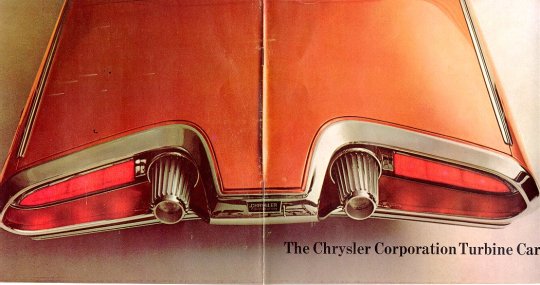
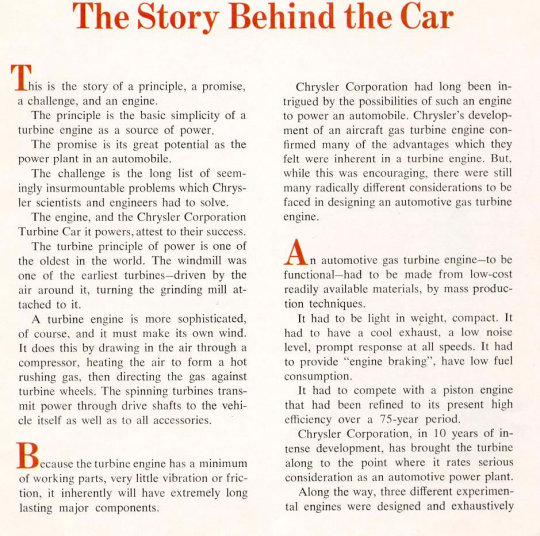
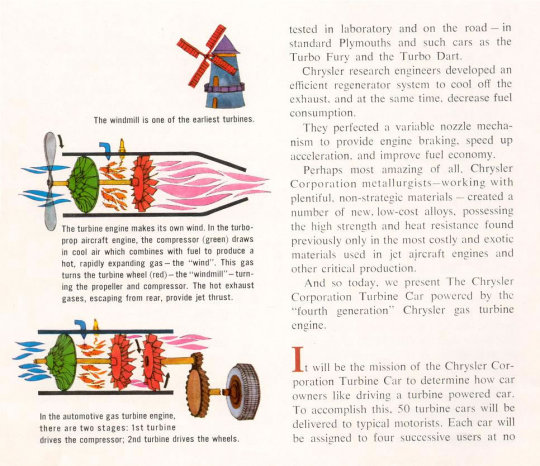


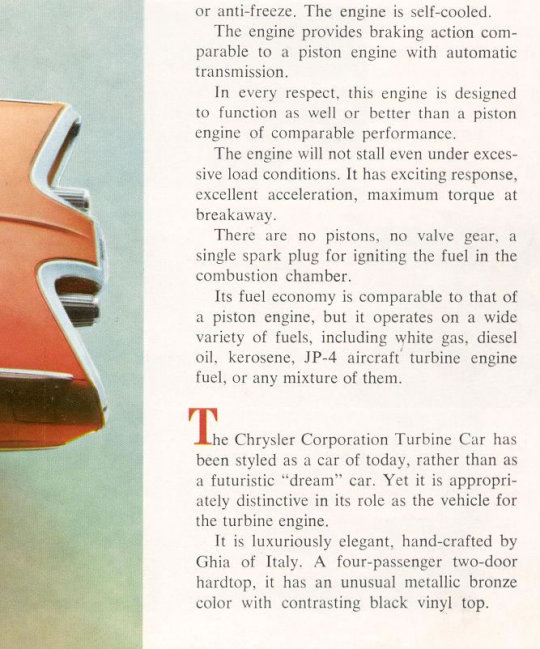




1963 Chrysler Turbine brochure
The program that produced the turbine car was started by Chrysler in the late 1930s, and came to fruition in 1963 with this futuristic design (by Elwood Engel who helped design the T-Bird) that looked like a space-age Thunderbird. The bodies were hand built in Italy by Ghia. 55 cars were built, including 50 that were for a public user program (203 individual drivers in 133 different cities).
The major problems with the turbine engine was poor fuel economy, noise, and a complicated starting procedure. The program was shelved in January 1966, and all but 9 cars were destroyed.
2 notes
·
View notes
Text




Imperial LeBaron 2-door Hardtop, 1969. The fuselage era began in August 1968 when Chrysler's new C-body cars for the '69 model year were revealed, designed under Elwood Engel. It was the first year a LeBaron coupe was offered. At 229.7 in (5.8 metres) it became the longest non-limousine car made in America.
#Imperial#Imperial LeBaron#Imperial LeBaron 2-door Hardtop#pillarless hardtop#1969#fuselage era#Elwood Engel#luxury car#big car#concealed headlamps
176 notes
·
View notes
Text

1969-71 Continental Mark III
Iacocca’s Lincoln: The Inside Story of the 1969-71 Continental Mark III
Lee Iacocca is remembered as the father of the Ford Mustang and the Chrysler Minivan, but there was another Iacocca vehicle that changed the Motor City: the Lincoln Continental Mark III.
In auto industry lore, the design studio guys hate it when the people from upper management start fooling around with their work. Nothing good can come from that, or so the story goes. But there’s at least one instance that cuts against the grain of that familiar Motor City tale. It was Ford senior executive Lee Iacocca who originated the two signature styling features of the Lincoln Continental Mark III: the classic stand-up grille and the faux tire bustle in the deck lid.
It’s no exaggeration to note that these visual features created a design theme and defined the Lincoln Mark Series brand for decades. Years later, lead designer L. David Ash would recall that neither he nor Styling VP Gene Bordinat had conceived these two now-famous design gadgets; no, in fact it was all Iacocca. “Neither one of us would have done it on our own, I’m sure,” Ash remembered. “I have to give Lee credit for that.”

As vice president of the Ford Motor Company’s car and truck group—top product boss, among other duties—Lido Anthony “Lee” Iacocca had at least two problems on his plate in the autumn of 1965. First, sales of the Ford Thunderbird had flattened out after a promising start years earlier. Meanwhile, Ford’s flagship Lincoln division wasn’t setting the world on fire, either. While the Elwood Engel-designed 1961 Lincoln was a style maker of the decade, it was nearing the end of its product cycle. Actually, Lincoln was a perennial problem for Ford senior management. According to Bordinat, it had never turned an actual profit since Henry and Edsel Ford acquired the company from the Lelands in 1922.
So a plan was hatched to build a new, small Lincoln on the same platform as the Thunderbird, which was switching to body-on-frame construction for 1967 (in part due to limited production volume). This would help the Thunderbird fill out production capacity at the Wixom, Michigan plant, and it would give Lincoln an entry in the rapidly expanding personal-luxury category, joining the Buick Riviera, Cadillac Eldorado, Olds Toronado, et alia.
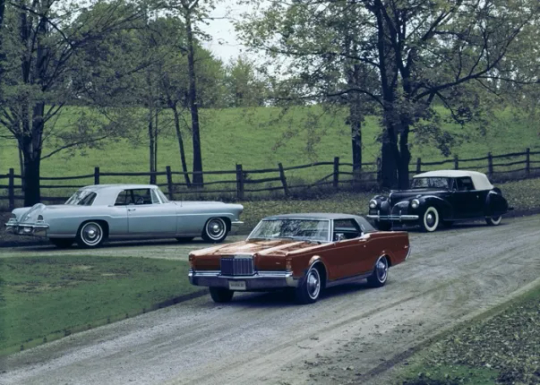
The original body design by Ash and his staff, at one point named the Lancelot, was clean and elegant but lacked visual punch, one could argue. Iacocca’s fake-Rolls grille shell and spare-tire bump fixed that, creating a distinctive and memorable look. It was said that the chrome grille shell was the most expensive such piece in the industry, with a unit cost nearing $200. Ash and crew completed the theme by hiking up the rear quarters and deck lid two inches, scrunching the roof down into the body for a classic ’30s profile.
From its exterior appearance, you might never know that the finished design shared its greenhouse with the Thunderbird coupe, or its floorpan, black metal, and 117.2-inch wheelbase with the T-Bird four-door. When Henry Ford II saw the clay model in the studio, he reportedly said, “I’d like to drive that home.” With the Ford family’s seal of approval secured, the new car was christened the Continental Mark III, establishing its lineage with Edsel Ford’s original 1939 Continental and the Continental Mark II of 1956-57. At that point the previous Mark III, IV and V models of 1958-60 were conveniently forgotten—today it would be called a reboot.
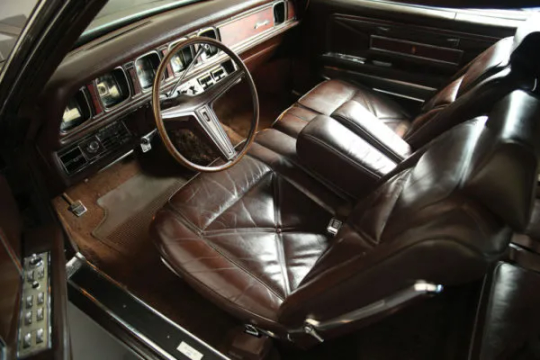
Introduced in April 1968 as a 1969 model, technically (Lincoln division downplayed model year designations, trying to present the car as “timeless”) the Mark III was panned by the critics but embraced by the car-buying public. “The buffs may not like it but the people with money will,” Bordinat wisely predicted. The Mark wasn’t big for an American luxury car at just over 216 inches long and 4,800 lbs, but it was big enough, with solid road manners and a comfortable ride. Interior specialist Herman Brunn covered the seats with rich, pre-creased leather, like the easy chairs in a men’s club. Noteworthy technical features included an all-new 460 CID V8 and Sure-Track, an early form of antilock braking developed by Kelsey-Hayes.
With a base price of $6,758 compared to $4,807 for its Thunderbird cousin, the Mark III was quite a moneymaker for the Motor Company, spawning an even more popular and profitable successor, the Mark IV (shown with Iacocca below). The Mark series, which comfortably outsold the Eldorado and effectively doubled the Lincoln division’s volume at times, continued on all the way to 1998 and the Mark VIII, and Iacocca would to on to further glories, including the Chrysler Minivan.

43 notes
·
View notes
Link
1968 Dodge Topless Charger Concept #StoryCars #ConceptCars #ConceptCar
0 notes
Text

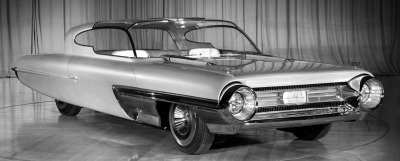




Ford La Galaxie, 1957 - A futuristic concept car designed by Elwood Engel that was presented at the Chicago Auto Show
0 notes
Photo

Éste Lincoln continental convertible es uno de los ejemplos más interesantes del diseño de Elwood Engel con leves modificaciones de Robert McNamara. Sus puertas suicidas hicieron un hito en la historia automotriz #lincoln #continental #convertible #v8 #másqueclásicosyogui #classiccar #classic #vintage #car #auto #carhistory #history #lincoln #lincolncontinental @lincoln_mexico https://www.instagram.com/p/CF5iPHNMdL-/?igshid=10ih96g4qsrgt
#lincoln#continental#convertible#v8#másqueclásicosyogui#classiccar#classic#vintage#car#auto#carhistory#history#lincolncontinental
0 notes
Photo

Spending boxing day trudging through muddy woods in freezing temperatures to take pictures of rusty old cars isn’t everybody’s cup of tea, but it is ours. This 1965 Chrysler 300 was captured one year ago today at Bonner’s Auto Parts. 1965 was a big year for Chrysler and in a way, for the 300. All Chryslers were totally redesigned that year, sporting a completely new look courtesy of the Corporation’s new design boss Elwood Engel. The 300, expanded into two ranges of cars in 1962, offered both regular “performance” sedans, coupes, and convertibles and had one last range-topping powerhouse letter car, the 300-L. This isn’t a letter car, but it’s not far off. As you’d expect when a halo car goes mainstream, the regular 300s were good sellers but diluted the letter car’s image. The “regular” 300s replaced the old Chrysler Windsor in 1962 for the purpose of putting some excitement into the lineup as a whole. With DeSoto now gone and Dodge drastically downsized, the base Newport shot up in sales, but the 300 also did better than the Windsor, no doubt buoyed by the famous performance name. The letter cars were still hot numbers in the early 1960s but they got less attention over time as other cars got faster and compacts and Pony Cars appeared, which captured the attention of performance buyers. In the meantime, Chrysler Pres Lynn Townsend recruited Engel from Ford to replace Virgil Exner, whose styling had gotten too weird for the boss and who was unfairly blamed for the disastrous “downsizing” decision of 1962 (a move he had bitterly opposed). Engel, creator of the slab-sided ‘61 Lincolns, took a personal interest in the first new ground-up designs he did for Chrysler and the ‘65 Chrysler came out looking razor-sharp and clean. The overall shape came from Bud Gitschlag in Chrysler’s advanced studio, the detail work by Roman Baranyk, Chet Limbaugh, and Don Wright, among others. In this redesign, the 300 proved even more popular, and buyers could option their car just like a 300-L, right up to the 360-hp 413 Wedge V8. Making two sets of 300s, one of which sold in tiny numbers (the letter car) was deemed inefficient, so the 300-L was the last letter car. https://www.instagram.com/p/CJRkCuPFvz6/?igshid=1x79eq45ve4t2
0 notes
